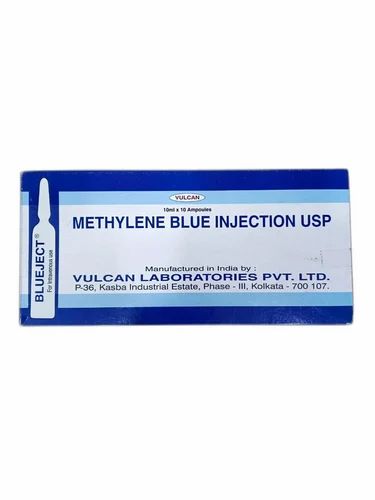Unlock wellness with exclusive discounts today!

Methylene Blue Injection USP
Sterile solution for medical use
€149.00
Out of stock
Discover Methylene Blue Injection —your trusted solution for clinical needs. Each box contains 10 sterile ampoules, each with 10 ml of high-quality methylene blue, known for its distinct deep blue color. Specially formulated for intravenous or intramuscular administration, this product is designed to ensure consistent results and safety when used under medical supervision. Packaged securely for optimal preservation, it is an essential addition for hospitals, clinics, and professional healthcare providers seeking reliable pharmacological support.
Benefits of Methylene Blue
Methylene Blue (MB) is a synthetic dye with a long history of use in medicine, dating back to the late 19th century. Its diverse pharmacological properties make it useful in several clinical and research applications.
Here are the key benefits and uses of Methylene Blue:
* Treatment of Methemoglobinemia:
* Primary Indication: This is the most well-established and FDA-approved use of Methylene Blue. Methemoglobinemia is a condition where the iron in hemoglobin is oxidized from the ferrous (Fe^{2+}) to the ferric (Fe^{3+}) state, rendering it unable to bind and transport oxygen.
* Mechanism: MB acts as an electron acceptor. It is reduced by NADPH-methemoglobin reductase (NADPH-diaphorase) to leukomethylene blue. Leukomethylene blue then donates electrons to methemoglobin, reducing the ferric iron (Fe^{3+}) back to ferrous iron (Fe^{2+}), thereby restoring hemoglobin's oxygen-carrying capacity.
* Clinical Relevance: Crucial for treating methemoglobinemia caused by various agents like nitrates, nitrites, local anesthetics (e.g., prilocaine, benzocaine), dapsone, and certain chemicals.
* Diagnostic Agent:
* Surgical Localization:
* Parathyroid Glands: Used during parathyroidectomy to help identify abnormal parathyroid glands, as they can selectively absorb the dye.
* Fistulas and Leaks: Employed in various surgical procedures (e.g., gastrointestinal, urological) to detect leaks from anastomoses or to identify fistulous tracts due to its vivid blue coloration.
* Renal Function Assessment: Can be used in some diagnostic tests to assess glomerular filtration rate.
* Chromoscopy: Used in endoscopy to stain specific tissues for better visualization of lesions or abnormalities.
* Antimicrobial and Antiparasitic Properties:
* Malaria: Methylene Blue has been recognized for its antimalarial properties since its discovery. It's effective against various stages of the Plasmodium falciparum parasite, including gametocytes, which are responsible for human-to-mosquito transmission. Its low cost and potential to combat drug resistance make it an attractive option, particularly in resource-limited settings.
* Urinary Tract Infections (UTIs): Due to its antiseptic properties and excretion in urine, it has been used in some formulations for the management of UTIs.
* Fish Diseases: Commonly used in aquaculture as a general antiseptic and antiparasitic agent for treating fish diseases.
* Topical Antiseptic: In some over-the-counter preparations, it's used for minor cuts and abrasions.
* Neuroprotective and Cognitive Enhancement (Emerging Research):
* Mitochondrial Respiration Enhancer: MB can accept electrons directly from NADH and donate them to cytochrome c in the electron transport chain, bypassing Complex I and III. This can improve mitochondrial efficiency and ATP production, especially under conditions of mitochondrial dysfunction or hypoxia.
* Antioxidant Properties: It acts as an antioxidant, scavenging reactive oxygen species (ROS) and preventing oxidative damage to cells.
* Neurotransmitter Modulation: Research suggests it may have effects on monoamine oxidase (MAO) and cholinesterase enzymes, potentially influencing levels of neurotransmitters like serotonin, dopamine, norepinephrine, and acetylcholine. This has led to interest in its potential for:
* Alzheimer's Disease: Explored for its potential to inhibit tau protein aggregation, a hallmark of Alzheimer's.
* Cognitive Enhancement: Some preliminary studies and anecdotal reports suggest it may improve memory, focus, and overall cognitive function.
* Depression/Anxiety: Its MAO inhibitory properties suggest a possible role in mood regulation, though this is not a primary therapeutic use.
* Brain Injury: Under investigation for its potential to mitigate damage in conditions like stroke and traumatic brain injury by improving mitochondrial function and reducing oxidative stress.
* Other Potential Therapeutic Uses:
* Vasoplegic Syndrome/Refractory Hypotension: In severe cases of distributive shock (e.g., septic shock) that are unresponsive to conventional vasopressors, Methylene Blue has been used off-label due to its ability to inhibit nitric oxide synthase and guanylate cyclase, leading to vasoconstriction.
* Cyanide Poisoning: Although hydroxocobalamin is the preferred antidote, Methylene Blue can be used as an alternative in some cases of cyanide poisoning, particularly if methemoglobinemia is induced to trap cyanide.
* Psoriasis: Investigated for its anti-inflammatory and antiproliferative effects in dermatological conditions.
Important Considerations:
* Dose-Dependent Effects: The effects of Methylene Blue are highly dose-dependent. Low doses often produce beneficial effects, while high doses can be pro-oxidant and toxic.
* Contraindications: Contraindicated in patients with G6PD deficiency (glucose-6-phosphate dehydrogenase deficiency) due to the risk of hemolytic anemia. It can also interact with serotonergic drugs, potentially leading to serotonin syndrome.
* Discoloration: A common side effect is the blue-green discoloration of urine, feces, and sometimes the skin and mucous membranes.
* Prescription Status: For most medical indications, Methylene Blue is a prescription medication and should only be administered under the supervision of a qualified healthcare professional. Its use in areas like cognitive enhancement is still largely experimental and not yet approved by major regulatory bodies.
In summary, Methylene Blue is a fascinating compound with a clear role in treating methemoglobinemia and various diagnostic applications. Its emerging potential in neuroscience and other therapeutic areas is a promising field of ongoing research.
Golden Drip
The transformative energy of nature for dynamic health solutions.
Beauty
Care
info@goldendrip.net
© 2025. All rights reserved.
